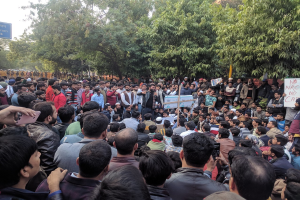Summary
This paper examines student activism in the past decade in North India and the reasons for students becoming more vocal, particularly against the government, in current day India.
Why are Students Protesting?
Fifty per cent of India’s population is under the age of 25, with approximately 20 million of them enrolled in Indian universities and colleges. With such a huge cohort, protests in university campuses are quite a common feature of democratic India. However, between 2009 and 2014, there has been a 148 per cent rise in student-led movements across the country. There was a 55-per cent increase in demonstrations during the same period, an average of 200 protests a day. The frequency of student agitations rose from 6,005 in 2011 to 7,385 in 2012 and 11,748 in 2014. In 2016, the number of student-led protests comprised 8.81 per cent of total protests in the country.
The student movement in India is not a monolithic entity. Rudrani Dasgupta, an activist, pointed out that, while there is currently a focus on the Hindutva right-wing agenda, there is a long-term movement around the Dalit identity, agitating against the systemic oppression of the backward and lower castes by upper-caste Hindus. Tamseel Hussain, a social media influencer and storyteller, cautioned that the protests may have become “more visible” now due to the current Bharatiya Janata Party (BJP) administration but that protests on both sides of the political divide have been present for several decades.
What are some of the issues students are protesting against?
The first is youth unemployment. The unemployment rate spiralled to a five-year high, to five per cent in 2015-2016 despite the BJP government launching high-profile programmes like ‘Make in India’ to promote job creation and inclusive growth. In 2019, 33 per cent of India’s skilled youth remained jobless. The top concerns of those in the 18 to 21-age group include Prime Minister Narendra Modi’s failure to deliver on his promise of creating 10 million jobs a year, a pledge that had won him the hearts of India’s youth in the 2014 elections.
Second, the campus protests are symptomatic of a larger issue. Students see the need for a platform to articulate concerns that they feel are not being addressed by universities and government authorities. For example, the Modi regime introduced some fundamental changes to the country’s higher education. The University Grants Commission’s (UGC) budget was reduced by almost 55 per cent, which, in turn, disrupted academic activities, with almost 60 per cent of academic posts lying vacant in centrally sponsored colleges and universities.
More Vocal Student Activists
There are several reasons for student activists becoming more vocal in North India.
The first is the collective frustration which resulted in the massive mobilisations across the country during the recent protests against the Citizenship (Amendment) Act 2019 (CAA) and the National Register of Citizens (NRC).
Second, students have begun to realise that they have been “cheated by aggressive right-wing nationalism”. The jury is still out on whether this sentiment is only restricted to bigger universities or has it percolated down to the provincial and urban youth. However, with the Rashtriya Swayamsevak Sangh (RSS) and the BJP working on undoing the idea of India – visible by the constant attacks on Jawaharlal Nehru and his legacy, for instance, – this is catalysing the youth on the other end of the political spectrum into action. During the protests against the CAA and NRC, when the police assaulted students from Jamia Milia Islamia University and the Jawaharlal Nehru University (JNU), two things happened: the baton was passed from the students to several Muslim mothers and women who organised sit-ins to protest; and the attack on the students brought into the fold those who were previously apolitical or apathetic.
Third, right-wing student outfits like the Akhil Bharatiya Vidyarthi Parishad (ABVP) of the RSS have become emboldened by the rise of the BJP. The ABVP, not only in JNU, Delhi University, Hyderabad and Banaras Hindu University, but also in many other universities, has confronted student leaders belonging to rival political parties like the Left parties, the Congress and other socialist parties. Many in the latter camp have been charged with treason and sedition for being “anti-nationalists”.
Fourth, social media has enabled student leaders across cities build solidarity and tap on the groundswell of youth angst.
Conclusion
Student agitations in India have been increasing steadily in the last decade. The ferment gripping the country since the passage of the CAA in December 2019 – the student unrest, public protests and police brutality – is merely reflecting the current high political stakes. Having said that, this Hindu nationalist narrative may pertain more to North India with its distinct history vis-à-vis the Mughals and linguistic traditions (Hindustani). It would be interesting to carry out a similar analysis for South India.
. . . . .
Ms Eirliani Abdul Rahman works with Nobel laureate Kailash Satyarthi. She won the 2015 BMW Foundation Responsible Leaders Award. She can be contacted at eirliani@gmail.com. The author bears full responsibility for the facts cited and opinions expressed in this paper.
Photo courtesy: By DiplomatTesterMan – Own work, CC BY-SA 4.0, https://commons.wikimedia.org/w/index.php?curid=84919519
-
 More From :
More From :
-
 Tags :
Tags :
-
 Download PDF
Download PDF



